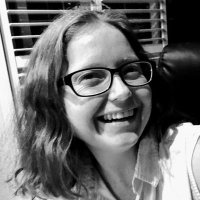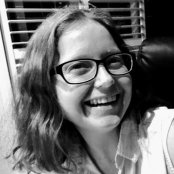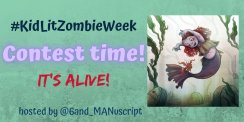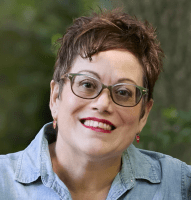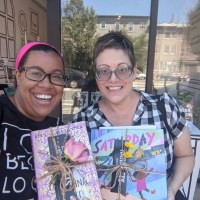I’m so excited to welcome Rachel Stark, editor at Disney-Hyperion, to the Mixed-Up Files!
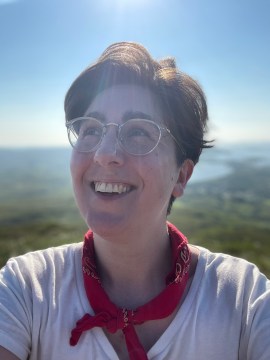 Rachel (they/them) is an editor, marketer, and activist with almost a decade of experience in children’s and young adult publishing at houses including Disney-Hyperion, Macmillan, Scholastic, Simon & Schuster, Bloomsbury, and Sky Pony Press. The award-winning and bestselling authors they’ve edited include Alexandra Bracken, Erin Bow, Jason June, Pablo Cartaya, Jen Wang, Rainbow Rowell, Faith Erin Hicks, Ben Hatke, John Patrick Green, Zach Weinersmith, and more. Books they have edited have been #1 New York Times, Washington Post, and Publishers Weekly bestsellers; been longlisted for the National Book Award for Young People’s Literature; won the Goodreads Choice Award, Asian/Pacific American Award for Children’s Literature, and Christopher Medal; been shortlisted for the Schneider Family Book Award; received multiple starred reviews; appeared on the Kids’ Indie Next List and myriad state award lists, and been listed as best books of the year by NPR, Kirkus Reviews, School Library Journal, and more. Not only that, but (unbeknownst to me when I first reached out to them) they were the editor for our very own MUF member Natalie Rompella’s novel Cookie Cutters & Sled Runners!
Rachel (they/them) is an editor, marketer, and activist with almost a decade of experience in children’s and young adult publishing at houses including Disney-Hyperion, Macmillan, Scholastic, Simon & Schuster, Bloomsbury, and Sky Pony Press. The award-winning and bestselling authors they’ve edited include Alexandra Bracken, Erin Bow, Jason June, Pablo Cartaya, Jen Wang, Rainbow Rowell, Faith Erin Hicks, Ben Hatke, John Patrick Green, Zach Weinersmith, and more. Books they have edited have been #1 New York Times, Washington Post, and Publishers Weekly bestsellers; been longlisted for the National Book Award for Young People’s Literature; won the Goodreads Choice Award, Asian/Pacific American Award for Children’s Literature, and Christopher Medal; been shortlisted for the Schneider Family Book Award; received multiple starred reviews; appeared on the Kids’ Indie Next List and myriad state award lists, and been listed as best books of the year by NPR, Kirkus Reviews, School Library Journal, and more. Not only that, but (unbeknownst to me when I first reached out to them) they were the editor for our very own MUF member Natalie Rompella’s novel Cookie Cutters & Sled Runners!RS: Thanks so much for having me! I’ve been reading this blog for so long, it’s kind of wild to actually be featured.
MMD: What was your path to becoming an editor? Did you always represent children’s books?
RS: I was a big reader as a kid, and I always knew I wanted to work with books—I just didn’t realize that there were ways to work with books other than writing them. As a freshman in high school I picked up Betsy Lerner’s The Forest for the Trees, which is an editor’s advice to writers. Reading about what Betsy herself did as an editor was a lightbulb moment, and in the way of a fourteen-year-old gifted kid who’s pretty sure they know everything and can do anything, I set my sights on editing then and there.
My actual path to the role I’m in now was, of course, far more complicated than my fourteen-year-old self imagined. After several internships I worked in textbook editorial and then children’s book marketing, and by the time I started editing full time I’d been in the industry five years already.
And no, my path wasn’t always aimed at kids’ publishing! At fourteen I wanted to edit adult literary fiction, but one of my first internships was at Scholastic’s former Arthur A. Levine Books imprint, and after I moved on to the next thing I found I couldn’t stop thinking about the books I’d read and the community of optimistic, brilliant creators I’d discovered there. I dove into kidlit and never looked back.
MMD: What were some of your favourite middle grade books to read when you were growing up? Would you say that has influenced what you look for in terms of representing MG books?
RS: This is always a fun and slightly embarrassing question to answer, because though I was a huge reader as a kid, what I liked to read then is only a fraction of what I love to edit now. As a kid I read almost exclusively books with unicorns, horses, or wolves on the cover. I loved Jean Craighead George—I still want to train a falcon like Frightful in My Side of the Mountain, and if I could trade everything to go back and be raised by wolves, I would. Joanna Campbell’s Thoroughbred series made me dream of being a jockey until I grew way too tall for it. And I treasured Bruce Coville’s Into the Land of the Unicorns and Jeremy Thatcher, Dragon Hatcher; if I branched out from horses and wolves, it was usually to fantasy.
I had to go back as an adult and read a lot of the classics that came out when I was younger, but I’ve since fallen in love with a much wider array of genres, and my list reflects that. I do think my childhood reading influences me; my taste leans literary and layered, and quote-unquote animal books sometimes get excluded from that category—but I still have a soft spot for the stories I know I would have loved. Cookie Cutters & Sled Runners is a great example of a book I’d have picked up for the dog on its cover, and then fallen in love with for its wonderful characters and impeccable representation of neurodivergence. And if you keep your eye on PW you’ll someday hear about a series I just acquired that perfectly marries the kind of story I loved as a kid with the kind of empowering narrative I want the kids of today to have.
MMD: What are some favorite middle grade books you’ve worked on in the past? And what are some you’ve worked on recently that our readers should look out for?
RS: Cookie Cutters & Sled Runners is the first book I ever acquired and will always hold a special place in my heart. I recommend Jen Wang’s Stargazing constantly—it’s such an empathetic, sweet, and funny story with wonderful characters. Ben Hatke’s Mighty Jack & Zita the Spacegirl and John Patrick Green’s InvestiGators were both so much fun to work on, and I love cheering for those creators and series as they keep finding more fans. The middle grade I’m most proud of by far is Simon Sort of Says by Erin Bow, which came out in January and has gathered a host of award nominations and fabulous reviews. It’s a wildly ambitious, laugh-out-loud funny and heart-wrenchingly timely novel about a kid finding himself, his friends, and his voice again after surviving gun violence at school. It sounds like a downer but it’s full of heart and levity thanks to Erin’s genius for finding light in darkness and using it to keep on going. I could talk about it forever.
MMD: What is your top advice for writers?
RS: I’m struggling to come up with one single piece of advice because that’s so dependent on each writer’s strengths and needs. But I’ll share something small that goes a long way toward building goodwill at your publisher: When writing your acknowledgments, ask your editor to send you a list of the people in house who worked hard on your book but who you may not have known were involved. It takes a village to make a book, and you likely don’t realize how many people have poured their energy into yours. Editors and publicists are often the people whose work is most visible to authors and so they’re used to being thanked, but for the sales assistant who really rallied behind you, the marketer who handsold your book at every con, or the managing editor who saved everyone’s butt when it came to making printer deadlines, it means so much to have their work seen and valued.
MMD: What advice would you give to a debut author? Both in terms of working with their editor and in general?
RS: Broadly, I think my biggest advice is to focus on the things you can control. There’s so much that’s out of your hands, that’s out of even your publisher’s hands. You can write an award-worthy book that happens to publish in the same year as many award-worthy books, or in a year where the award committees are interested in something other than what you’re doing. Market conditions and buying practices can change in a heartbeat, budgets can be slashed or imprints consolidated, key cheerleaders could move to other jobs, delays or paper shortages or pandemics or any number of unpredicted obstacles can suddenly topple the best-laid plans. . . .
You’ve likely been dreaming for years about what your debut experience will be like, and now that it’s here you’ll want all the stars to align just right. But remember that you can’t control the stars.
What you can control is writing the best book you can write, and then writing the next one, and the next one. That first book is just the start of what for most writers is a long and winding career, where the models for success are as many and varied as the books on your shelf. If it doesn’t go the way you hoped? Get to work on the next one.
MMD: After the high of having sold a book to a publisher, many authors I know, myself included, have a big cry when they receive their editorial letter. I think that as much as authors know that however many drafts they’ve done on their book it kind of gets set back to zero once they begin the editorial process, seeing that letter can be demoralising no matter how gently it’s written. Whether it’s a debut author or an author working with you for the first time, do you find that the relationship requires managing expectations and building trust?
RS: The editor-author relationship requires a huge amount of trust! It’s intensely vulnerable to receive critique, and I find that the process of digging deep into a story to make it the best it can be often demands that the author and I dig deep into ourselves. It takes both trust and care to create a space where we can do that.
With regards to that initial shock you feel on receiving feedback—it’s incredibly hard to write a novel and incredibly hard to revise one, and of course cresting one mountain to realize there’s another ahead is going to be daunting! Whatever you feel in that moment, it’s understandable. But remember that your editor chose to work with you on this project, and feedback is a show of our investment in your work reaching readers and being well received. We wouldn’t be putting so much time and emotional energy into your work if we weren’t wildly in love with your writing and excited about the story you’re working to tell.
MMD: That is really helpful advice, thank you.
I loved this interview with you at Kirkus. https://www.kirkusreviews.com/news-and-features/articles/rachel-stark-freelance-editor/. What are some pros and cons for being a freelance editor vs being in-house?
RS: An interesting question, and my pros and cons are pretty specific to me. For context, I didn’t initially choose to go freelance; I mysteriously found myself lacking a job after supporting a union drive 😊. But it was exactly what I needed after that experience. Being able to choose my projects and clients, working with people who enthusiastically wanted to work with me, and having enough flexibility to reinvest in other hobbies and give myself breaks from thinking about work were all wonderful. I was lucky to have a lot of opportunities to use my freelance work to get firsthand experience in genres and formats I’d always been interested in but not yet exposed to—the expertise I gained in graphic novels has proven invaluable in my job at Disney-Hyperion—and to work with editors and authors I’d always admired. The down side, beyond the obvious stuff like lack of benefits and the potential for the work to dry up, was that I wasn’t getting the opportunity to build a list and a reputation of my own. By the time Disney-Hyperion offered me a role, I was ready to take what I’d learned and start building a reputation for the books I acquired and ushered successfully to market.
MMD: What kind of projects did you/do you work on as a freelance editor—for example are they projects where an author is trying to get their book to the level needed to get an agent, or are they at other stages? What are some reasons someone might be interested in a freelance editor?
RS: Because of the connections I had, I actually found myself in the position of working mostly on books that had already been signed up for publication, but that needed an extra perspective, someone to keep them moving while an editor was out, or just someone who could give that individual book more time and attention than the full-time staff who were torn between millions of priorities. So mostly I was being hired by publishers rather than by writers. I did take on a couple of projects from authors looking for an agent or a book deal, and I found that often they’d taken their manuscript as far as they could take it and still weren’t getting the responses they wanted, so they were looking for an outsider’s perspective on how they could keep developing their craft. Some writers reached out to me before even going on submission, just to have the benefit of feedback from a fresh set of eyes. The writing process is so solitary, it can be immensely helpful to have someone to bounce ideas around with and to help you see your strengths and areas to improve in.s
MMD: I know that in your long time in publishing you have also worked on the marketing side, including high profile campaigns for New York Times–bestselling books and series, as well as winners of the Caldecott Medal, Newbery Honor Medals, the Coretta Scott King Award, the Stonewall Book Award, the Walters Award, and more. Do you find that your experience in marketing influences your editorial work and style?
RS: For a lot of the time I spent in marketing I was dying to become an editor, and it was frustrating to not be there already—but in retrospect that experience was so valuable. It changed how I think about what I acquire and what I hope success to look like for each book. And having worked outside of editorial I have an even greater sense of empathy and appreciation for how hard everyone is working in all departments to make books shine. Something folks don’t realize about editors’ role is that a lot rests on the relationships we have with colleagues, and how and when we’re able to get them excited about what we’re working on, our ability to brainstorm and build alongside each other, and what we can learn from them—so the added camaraderie I get from knowing what it’s like to be in their position is invaluable. I think the effects of my marketing experience are more visible on the publisher’s side than in my relationships with authors and agents, but it has brought me great books! Simon Sort of Says actually came to me because I had marketed one of Erin Bow’s books and we had a mutual admiration from that time.
MMD: What genres, themes etc are you looking for at Disney and where can people find out more details about this?
RS: I acquire original novels and graphic novels for middle grade and adult readers, and I have a wishlist I update regularly here: https://rachelstark7.wixsite.com/home/general-1. Unfortunately Disney’s policy is that I can’t accept unagented queries, unless I’ve specifically requested them at a conference or convention. But I do find that sometimes after writers find an agent they remember that I seemed like a fit and point their new agent in my direction—I hope Mixed-Up Files readers who liked what I’ve had to say and write in these categories will do that!
MMD: What are your socials and/or the best way for people to keep up to date with you?
RS: The best places to connect with me are Bluesky (syntactics.bsky.social) and Facebook (@EditorStark, https://www.facebook.com/EditorStark/)/. I’m also (regrettably and half-heartedly) on the Website Formerly Known as Twitter as @syntactics.
MMD: Rachel, it’s been such an honor and education speaking with you, and I know our readers will get so much out of your responses. Thank you so much for joining us!

